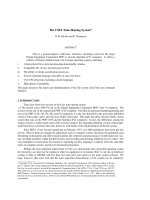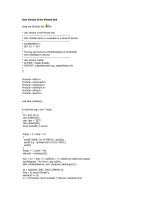Lesson Unix shells
Bạn đang xem bản rút gọn của tài liệu. Xem và tải ngay bản đầy đủ của tài liệu tại đây (667.55 KB, 14 trang )
Unix Shells
Unix Shells
Types of Shells
Unix Overview
1
Types of Shells
Why use shells?
• Easiest way to string Unix commands
together for execution
• Ease of reading
• Generally portable across Unix
Types of Shells
Bourne Shell - sh
• First shell
• Compact syntax
• Contains some powerful built-in
constructs
• Used on most Unix systems to start
and configure the operating system
Unix Overview
2
Types of Shells
C Shell - csh
• Similar to C language
• Usually used as the default logon shell
• Many functions available
Types of Shells
Korne Shell - ksh
• IBM’s AIX flavor of Unix
• Considered to be a superset of the
Bourne Shell
• Extensions over the Bourne Shell
exceed the functionality of the C Shell
• Not fully portable
• ACI uses the Korne Shell as it’s
default shell
Unix Overview
3
Types of Shells
Bourne-again Shell – bash
• Default shell for most Linux operating
systems
• Superset of the Bourne Shell
• Uses command line completion to
match partly typed program names,
filenames, and variable names
Unix Shells
Profile File
Unix Overview
4
Profile File
The Profile file:
• Is a hidden file
-> .profile
• Executes when you logon
• Can be executed after logon
-> . .profile (note the leading dot)
• Used to set environment variables and
shell options
Profile File
Unix Overview
•
It is better to put aliases in a .env
environment file and configure your
.profile to execute the .env file.
•
You can have multiple environment files
depending on the ACI products you want to
access. Each product will have its own
environment variables file.
5
Profile File
.profile example
Profile File
.profile example continued
Unix Overview
6
Profile File
.profile executed after logon
Profile File
Executing aliases
Unix Overview
7
Unix Shells
Environment Variables
Environment Variables
• Environment Variables are used as
“shortcuts” for literal replacements
• They are used by shells, commands,
and programs
• Start with a $
Unix Overview
8
Environment Variables
•
Examples:
-> $PATH
• Where shell looks for commands
-> $CLASSPATH
• Where JAVA programs look for definitions
-> $ORACLE_HOME
• Where Oracle software is installed
-> $COBDIR
• Where COBOL compiler is installed
Unix Shells
Managing Processes
Unix Overview
9
Managing Processes
• In Unix, every process is assigned a
•
•
unique PID
Every process is also assigned a job
number that is unique to the current
session
PIDs are used globally across the
system to track processes
Managing Processes
Commands to manage processes
• ps
-> list your processes
• ps –ef -> list all processes
• jobs -> list session processes
• <ctrl>z -> to suspend a running process
• kill
-> to terminate a process
• Using PID number
• Using job number
Unix Overview
10
Managing Processes
The following example uses the ps and
jobs commands. I started a man help page
search on the ls command.
I then stopped the man search process
using <ctrl> z.
Managing Processes
Example using ps and kill commands
PID 25917
PID 306
Job 1
kill
306
kill-9%1
Unix Overview
11
Managing Processes
Example using ps, jobs, and kill commands
PID 25917
Job 1
kill %1
Managing Processes
The kill command is used to send a
signal to a process so an option number
must be included in the command
• Stop (20) -> SIGTSTP
-> kill -20 <PID number>
-> <ctlr>z <PID number>
• Kill (9) -> SIGKILL
-> kill -9 <PID number>
Unix Overview
12
Managing Processes
In Unix you can suspend jobs and
move them to the background or
move jobs from the background into
the foreground using the bg and fg
commands and add the job number
Unix Shells
Using man Pages
Unix Overview
13
Using man Pages
Unix provides command line help known
as the Unix Man Pages
• Man Pages are compressed text files
• Use Man Pages to find information
about commands, programs, utilities,
and coding and writing scripts
• Use the man command to invoke
-> man ls
Using man Pages
man command
Unix Overview
14









